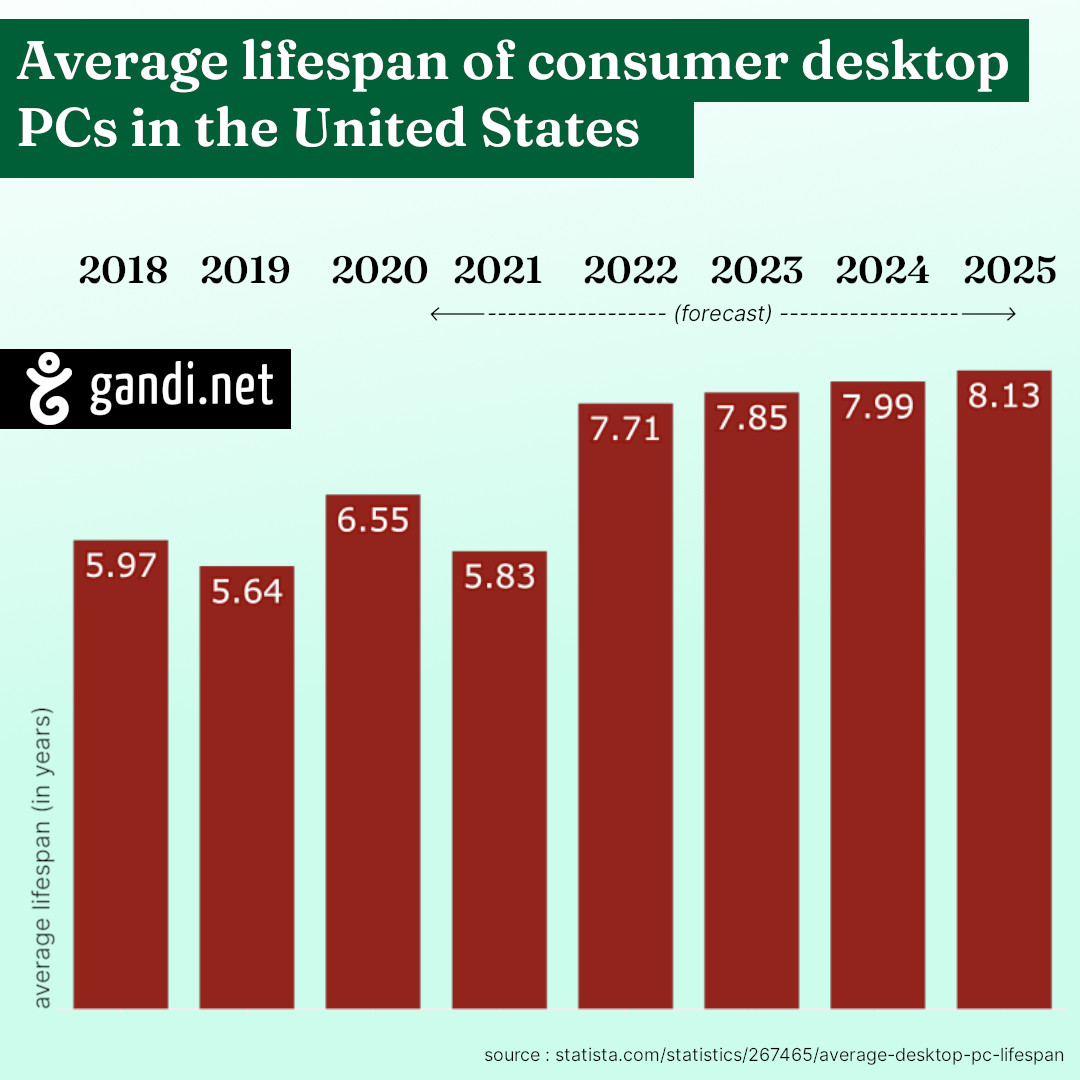Ecodesign, reducing the environmental impact of technology

Now we know that digital technology is not a green alternative to industrialization and climate change. This revolution didn’t stop at replacing paper with emails and supermarkets with online stores. Raphaël Lemaire, in his book on ecodesign [link in French], wrote: “The digital economy doesn’t replace the traditional economy, it adds to it.” It has had a non-neglible and growing impact on the environment, in the same way that the sectors traditionally singled out for theirs: transportation, construction, or intensive agriculture.
It’s necessary, then, to measure this impact, to equip yourself with the means and tools to include environmental friendliness among the criteria in the way we design digital services. We can then assure that at every level, collective and individual, this reflection also accompanies concrete actions.
1. Measuring the environmental impact of the digital economy
“The digital economy represents, depending on sources, between 2 and 6% of global greenhouse gas emissions, with a convergence of opinions around 4%,” Raphaël Lemaire reports, highlighting the difficulty in estimating this impact due to the multiple sources of emissions, from data to the transfer of digital services into the physical economy.
Datacenters: the cost of data storage and distribution
The cost of maintaining data on servers is the most intuitively obvious negative impact on the environment: there are around 5,000 datacenters spread across 130 countries that require constant energy input, including maintenance facilities, cooling, and more.
The International Energy Agency (IEA) estimates that in 2021 the global consumption of datacenters was between 200 and 250 TWh, or between 0.9% and 1.4% of global demand for electricity. Transmitting these data requires an even greater amount of electricity (260–340 TWh), to which we can now add consumption related to cryptocurrencies (100–140 TWh).
There’s some cause for optimism, though: this electricity consumption, linked largely to cooling data storage facilities, is growing less quickly than the number of users and the volume of data produced and exchanged per year. There is, then, some progress being made in terms of energy efficiency, along with a growing amount of renewable energy being used.
Still more personal computers
Even more than datacenters, the consumption of individual computers and their management at the end of their period of usefulness grows our carbon footprint. Two-hundred kg of raw materials are necessary to manufacture a single smartphone, estimates Erwan Fangeat from Ademe (ecological transition agency), in an interview by Les Numériques (link in French).
Among these raw materials, 30–50% are synthetic materials, 10–20% glass and ceramic, and the rest, 40–60% metal, copper, aluminium, chrome, etc. but also to a lesser extent, rare Earth metals extracted in China to “devastating” effect.
The organization Latitudes (linked page in French), a Gandi-supported project that works towards making our technology more sustainable, estimates the rate of smartphone sales in the world at 50 per second. Latitudes has also deduced from a quick calculation that the creation of new devices is what most heavily impacts the environment.
Our environmental impact depends, then, depends on slowing down the rate at which we replace our equipment: even if there’s a bit of marketing in the propensity of manufacturers to offer endlessly new products, there’s also a technical dimension that pushes our devices to rapid obsolecence. If this phenomenon seems to be slowing down for office machines, it’s still going quite strong for mobile devices.

This environmental cost of devices is, then, also linked to what digital services are available and their capacity to be used on older devices and machines.
Externalities related to the digital economy
But taking it a step even further, you realize that high-energy consumption storage and overconsumption of devices along with new usages and new services that also impact the environment. This utopian idea of computers and the internet as tools for dematerializing otherwise polluting activities has now been forgotten. A study by CNRS illustrates this phenomenon with a very telling example: the greenhouse gas emissions benefits from switching to electronic invoicing are mitigated by the more than one third of users who print their invoices.
More broadly, the increased exposure to promotional materials, a wider access to a greater number of products and markets and greater ease in delivery of these products, even from one side of the world to another, are all aspects of the democratization that digital technology offers. Building a website with an eye towards energy efficiency while saving consumers a few cents shipping products in container ships from across the planet doesn’t make sense.
The first step in ecodesign should then be verifying the usefulness and appropriateness of this service from a commercial point of view.
The technology industry is even going against the efforts made in other industries in terms of energy efficiency: the think tank The Shift Project reports that the energy use of the global GDP is dropping by 1.8% each year while the technology industry’s increases by 4% each year. The transition to digital technologies has not resulted in decoupling the economy for its physical basis nor has it managed to neutralize its environmental impact: while we’ve replaced paper with PDFs and disks with mp3s and streaming, these are just tiny drops in a giant ocean of digital services.
2. Providing the means to take action
Once this observation has been made, it’s important not to consider this as fatal. Digital technology comes necessarily with an environmental cost. What’s necessary, then, at all levels is to include environmental constraints in your reflections, provide this aspect of digital activity with the means, particularly in terms of human resources, and be able to measure the impact of actions taken.
Tools for measurement and objectives to reach
Each of these environmental cost categories should then be treated conjointly and this necessary optimization requires appropriate measurement tools.
As such, these datacenters now show a ratio, the Power Usage Effectiveness (PUE), which determines the relationship between the total energy consumption and the sum of the consumption of each piece of equipment. The goal being to determine which part of this energy usage is consecrated to the simple cooling of servers. While most datacenters have a PUE of up to 1.7, you’ll need to, by various means, manage to reduce this number.
Collective commitments are now being taken by different providers to reduce this number. The Climate Neutral Data Centre Pact links its signatories to energy efficiency requirements:
- As of January 1, 2025, new datacenters will have a PUE of 1.3 (or 1.4 according to geographic zone)
- Starting in 2023 all the datacenters requiring a maximum power input of 50 kW will follow these restrictions
If we are able to set these energy efficiency goals with regard to data storage, we can also look to measure and reduce data to ensure the same level of service. There are, then tools like the GreenIT-Analysis plugin (for Chrome or Firefox) or the Website Carbon Calculator which enable you to measure the environmental impact of our webpages by taking account of metrics like page size, the number of requests, etc.
An energy efficiency benchmark
Even if measurement tools exist and allow work towards improving environmental efficiency, the requirement to do so goes beyond the good faith of economic actors. It’s necessary, then, for there to be a benchmark designated, either internal or external, within organizations, businesses, research institutions, educational institutions, etc. The problem of digital ecodesign being relevant to several features, it is indispensable to be able to rely on this benchmark to impose the necessary constraints to any new project.
3. Ecodesign on multiple levels
Once the problem of environmental impact is identified and tools are collected to better orient the design of your services, coordinated efforts are necessary so that best practices become the norm in the production and use of services.
What businesses can do
On the level of organizations providing digital services, and therefore businesses, notably, this responsibility takes several forms:
- Ensure that the upstream services they use (servers for example) are commited to energy efficiency, like Equinix, signatory of the previously mentioned Climate Neutral Data Centre Pact, or powered by green energy like LuxConnect, to name a couple of Gandi’s own partners
- Seek energy efficiency by reducing resource consumption at every step of the design process: compression of media files, deletion of old data, limiting background operations and even the choice of a more efficient programming language, all of these possible energy consumers
- Ask yourself about the inclusivity and pertinence of your products and services: do you offer a service that everyone can use, without material constraints? And above all, is your service useful? Does it justify the use of resources?
In order to be able to efficiently determine what’s significant and what is less significant in the process of ecodesign, IT professionals can turn to certification organizations to guarantee that you’re given sufficient attention to these issues. This process led Julien Fusco to focus his web design agency Ochelys (of which he is both founder and manager), on the user and as such also on the efficiency of features.
Various conversations, in particular with Frédéric Bordage, original author of the web ecodesign best practices repository (regularly updated over the past decade) and cofounder of the Alliance Green IT, led him to understand the convergence between these UX practices and ecodesign: “By a happy coincidence, it matches our principles, we didn’t realize that we were doing Green IT because the term didn’t even exist at the time.” Julien Fusco decided to take the certification course provided by the Alliance Green IT and made sure his employees were also trained in its practices. Beyond best practices, this type of training makes it possible to ensure your business processes take place in a way that’s friendly to the environment: “you can’t just ecodesign a website, you can only ecodesign a business,” Julien Fusco explains. Now, he talks about this certification even when “green” design isn’t specifically requested by his customers. What’s more, he wants to put forward the idea, which is not necessarily intuitive, that eco-friendly design also means efficient design, and that eco-friendly best practices in design, products, and features translate to greater optimization of digital resources.
What individuals can do to support ecodesign
Establishing norms that favor ecodesign and implementing them within organizations are good foundations for building a more responsible tech industry. But this institutional consciousness raising should also reach each of us as individuals in our personal use of digital tools. It’s also up to us to use services that are making the effort in the right direction and it’s up to us to understand the carbon footprint of our personal websites, and apply the advice of ecodesign experts:
“There are a few repositories of best practices with all these ideas,” Raphaël Lemaire says, “The oldest and most well known of these includes 115 web ecodesign best practices from the responsible web design collective including V4 (which I partipcated in producing), with a large update that’s available open-source on Github. There’s also a very complete repository with 498 criteria, developed by the European Institutes for Sustainable IT, GR 491.” There are also guides available from sources such as the University of Michigan.
Now everything, or almost everything, is in place to make environmental requirements and ecodesign the norm in digital services, just like some cybersecurity approaches are today essential. The main means of doing so have been identified, certifications and lists of best practices exist. And even more importantly, the public has been sufficiently educated on these issues to be able to move towards greener uses and consumption of technology, which in itself can be seen as a radical act in response to an alarming situation which is potentially becoming the norm in the market.



